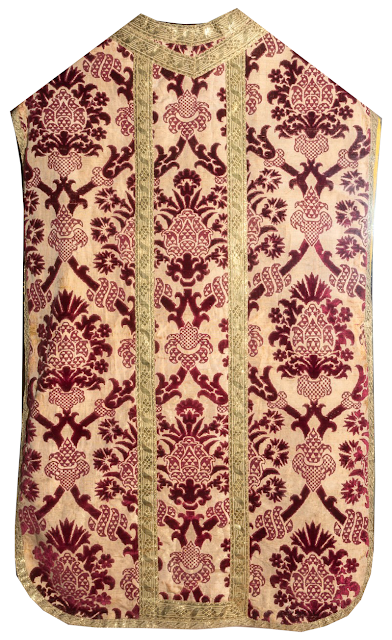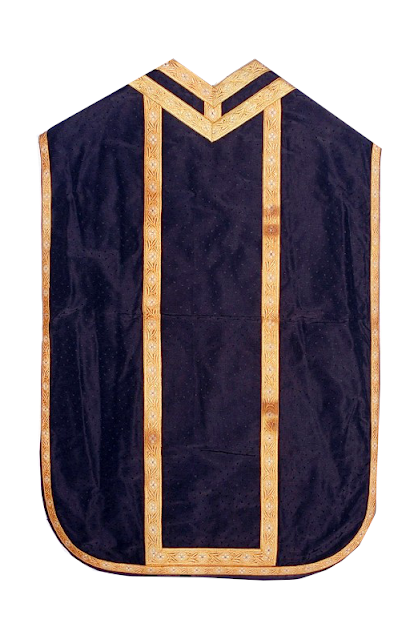Now, before proceeding any further, it must be said that this is by no means an absolute and so it should not be treated as such. If anything we might rather talk about this as a "design trend" but not a rigid, formulaic absolute.
In looking at these Italian variations, we must look toward the galloons that form the orphrey near the neck and we will consider three places: Florence, Venice and Rome. To give an example of what I mean, let us first consider a chasuble of Florentine manufacture. Here. if you look at the galloon design near the neck, one will see a semi-circular galloon lines the edge of the neck opening (which itself is founded) and beneath this is a "V" shaped galloon.
 |
| Florentine |
 |
| Florentine (front) |
By comparison, if we were to look further north toward Venice, we see a similar design; one which sees a rounded neck opening and a distinctive curvilinear "V" that is frequently spaced wider than its Florentine counterpart.
 |
| Venetian |
By contrast, if we turn toward Rome (and really much of Italy more generally given Roman influence), the neck opening itself at the back now takes a "V" shape and we find a double V galloon, frequently with a vertical line which connects the two of them.
 |
| Roman |
In the instances of both the Roman and Venetian models, the front uses the same parallel galloon placement:
 |
| Roman / Venetian front |
For most people, this level of minutiae will be of little interest or relevance of course, but for the connoisseur, or for vestment designer who is looking to move beyond the same repetitive designs, or for the student of 'paramentology' who is looking for clues that might help them to identify the particular provenance of a vestment, this sort of information could prove useful.
As noted earlier however, this is by no means a black and white matter. For example, you will find many chasubles of Venetian manufacture that have a design very similar to the Florentine. However, it certainly seems to be the case that we can frequently find these very localized design trends. In many regards the presence of such variations makes manifest sense, historically speaking, given that both the strong regonalistic tendencies of Italy, tied as they were to city state like entities, as well as a pre-industrial revolution world -- a time when the world was not the "global village" it now is; a time which better preserved local customs and distinctions. Within this context it takes little effort to understand that local ateliers would no doubt follow the established patterns in their own particular city or region, both for reasons of established trends if not also civic pride.
















